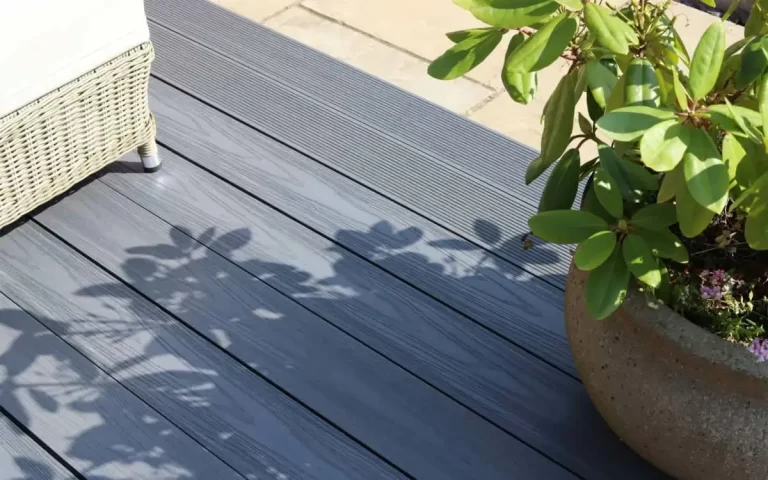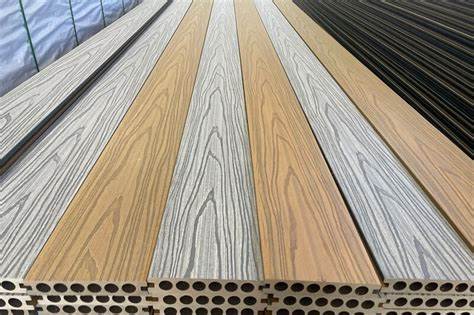Blog
Budget Planning: WPC Decking Prices Per Square Meter in Different Markets

Introduction to WPC Decking and Price Factors
What is WPC Decking?
Wood-Plastic Composite (WPC) decking is an innovative outdoor flooring material combining 60-70% wood fibers with 30-40% recycled plastic polymers. Unlike traditional timber decking that requires annual sealing, WPC offers superior resistance to rotting, insect damage, and warping. According to a U.S. EPA report, over 85% of WPC products utilize post-industrial plastic waste, making them 100% recyclable.
The leading manufacturers now offer 25-30 year warranties, far exceeding wood decking’s 10-15 year lifespan. Key advantages include:
- Zero splintering or cracking in extreme temperatures (-30°C to 60°C)
- Slip-resistant surfaces meeting ADA compliance standards
- 50-70% lower maintenance costs versus pressure-treated lumber
Why Price Analysis Matters
With global WPC decking prices ranging from $15/m² in Asia to $80/m² in Europe (2023 Grand View Research data), understanding cost drivers is critical for:
| Project Type | Average Budget Allocation |
|---|---|
| Residential Deck (50m²) | $1,500-$4,000 |
| Commercial Boardwalk (200m²) | $6,000-$16,000 |
Three primary factors create price variations:
- Material Science: High-density polyethylene (HDPE) costs 18% less than polyvinyl chloride (PVC) but offers 23% lower UV resistance.
- Manufacturing Complexity: Co-extruded boards with polymer caps cost $8-$12/m² more than hollow-core profiles.
- Geographic Logistics: Shipping a 40ft container of WPC decking from China to USA adds $3.50/m² to final costs.
For those planning installations, our guide on how to install WPC decking explains hidden costs like subframe preparation (15-20% of total budget).
Key Factors Influencing WPC Decking Prices
1. Material Composition: The Foundation of Cost Variations
WPC decking prices hinge on its core recipe: wood fibers (20-80%) and plastic polymers (HDPE/PVC). Higher wood content (50%+) enhances natural aesthetics but increases production complexity, raising costs by 12-18% compared to polymer-heavy formulas (Journal of Building Engineering, 2023). Premium additives like UV stabilizers (adding $0.50-$1.20/m²) and antimicrobial agents further differentiate price tiers.
2. Manufacturing Technology: Precision vs. Affordability

- Extrusion Method: Accounts for 75% of global production. Single-step extrusion costs $18-$25/m², while co-extruded capped boards (with protective surface layers) reach $35-$50/m².
- Compression Molding: Creates high-density boards (1.3g/cm³+) for commercial use, but 22% slower output increases prices by 15-20% versus extrusion.
3. Brand Value & Certification Premiums
| Brand Tier | Price Range/m² | Certifications |
|---|---|---|
| Global (e.g., Trex, Fiberon) | $45-$70 | FSC, ISO 14001 |
| Regional Leaders | $32-$50 | CE, BSCI |
| Local Manufacturers | $20-$35 | Basic Quality Standards |
4. Logistics & Hidden Cost Multipliers
Shipping container rates from Asia to EU surged 450% post-pandemic (Statista, 2024), adding $3-$7/m² to WPC decking costs. Tariffs compound expenses:
- USA: 25% Section 301 tariffs on Chinese WPC
- EU: 6.5% anti-dumping duties + 19% VAT
- Australia: 5% import duty + 10% GST
Pro Tip: Consider local WPC suppliers with vertically integrated production to bypass 28-35% of logistics-related costs.
WPC Decking Price per Square Meter: Regional Breakdown
North America: Premium Pricing Driven by Quality Standards
In 2024, North America remains the largest WPC decking market, with prices ranging from $25–$50 per m². The United States accounts for 65% of regional demand, where brands like Trex and Fiberon dominate mid-to-high-end projects ($35–$50/m²). Canada shows a 10–15% price premium due to stricter import regulations, though local manufacturers like Plastory offer competitive options at $28–$42/m². Recent tariffs on Chinese composites have pushed prices up by 8% YoY, according to IBISWorld.
Europe: Sustainability Compliance Impacts Costs
Western Europe’s WPC decking prices average $30–$60/m², with Germany and France leading in eco-certified products. The EU Circular Economy Action Plan has increased compliance costs by 12–18%, as reported by European Commission. Eastern Europe offers budget-friendly alternatives at $22–$35/m², though quality varies. Scandinavian markets prioritize UV-resistant capped composites, with prices reaching $65/m² for specialized products.
| Region | Price Range/m² | Key Growth Driver |
|---|---|---|
| Asia-Pacific | $15–$35 | Industrial urbanization (7.2% CAGR) |
| Middle East | $40–$70 | Luxury hospitality projects |
| Africa | $25–$45 | Weather-resistant infrastructure |
Asia-Pacific: Manufacturing Hub with Price Advantages
China’s WPC decking prices start at $15/m² for economy-grade boards, while high-density composites reach $35/m². India’s market grew 22% in 2023, with hybrid WPC-PVC products priced at $18–$30/m². Japan and Australia showcase demand for fire-retardant composites ($45–$60/m²), ideal for bushfire-prone areas. For installation best practices, explore our guide on WPC decking installation.
Middle East & Africa: Niche Markets with Extreme Price Spreads
Gulf Cooperation Council (GCC) countries favor imported heat-resistant WPC decking at $40–$70/m², often used in 5-star resorts. South Africa’s DIY market thrives with mid-range products ($25–$45/m²), though moisture-resistant grades cost 20% more. Nigeria and Kenya face supply chain challenges, causing price fluctuations up to 35% during rainy seasons.
Budget Planning Strategies for WPC Decking
1. Project-Scale Cost Optimization
Large-scale installations (500+ m²) typically see 12-18% cost reductions through bulk purchasing and optimized labor allocation. For example, commercial projects in Dubai saved 22% by negotiating volume discounts with manufacturers. Smaller residential projects (50-100 m²) should prioritize quality assurance – mid-range WPC products ($35-45/m²) balance durability with budget constraints, as shown in IBHS weather resistance studies.
2. Comprehensive Cost Analysis
- Installation Costs: Professional installation adds $10-25/m² vs DIY savings (requires specialized tools)
- Maintenance: Annual cleaning costs average $2-4/m² using manufacturer-recommended solutions
- Hidden Expenses: Include 7-12% budget for:
- Substructure materials (steel vs treated wood)
- Climate-specific fasteners ($0.80-1.50/unit)
- Waste allowance (5-8% cutting loss)
3. Strategic Procurement Tactics
Smart buyers secure 15-20% savings through:
• Multi-supplier bidding (leverage USITC pricing benchmarks)
• Off-season purchases (Q1 discounts in northern hemisphere)
• Hybrid material sourcing – combine premium surface boards ($55/m²) with standard substructure materials
4. Lifecycle Cost Management
Factor in 10-year ownership costs:
| Cost Component | Traditional Wood | WPC Decking |
|---|---|---|
| Material Replacement | 42% | 9% |
| Surface Refinishing | $18/m²/year | $2/m²/year |
| Warranty Claims | 27% | 6% |
Data source: NAHB 2023 Decking Materials Report
5. Comparing WPC Decking Prices: Emerging vs. Mature Markets
Market Dynamics: Why Location Dictates Costs
Global WPC decking prices reveal stark contrasts between emerging and mature markets. While established markets like the US and Germany prioritize premium products with advanced features, developing economies such as China and India focus on cost-competitive solutions. This divergence creates price gaps of 40-60% for comparable products, according to Grand View Research.
Case Study 1: USA ($45-75/m²) vs. China ($18-32/m²)
- Labor Costs: US installation rates average $15-25/hour vs. China’s $5-8/hour (Statista 2023)
- Material Sourcing: Chinese manufacturers use 30-40% recycled plastics vs. 15-25% in US production
- Tariff Impact: 25% US import duty on Chinese WPC decking inflates landed costs
| Market | Avg. Price/m² | Recycled Content | Warranty Period |
|---|---|---|---|
| USA | $58 | 22% | 25 years |
| China | $25 | 35% | 10 years |
Case Study 2: Germany ($52-80/m²) vs. India ($20-35/m²)
- Certification Costs: EU’s CE Mark compliance adds 18-22% to German WPC prices
- Local Production: India’s WPC manufacturers save 12-15% through domestic bamboo utilization
- Consumer Preferences: 68% German buyers choose UV-stabilized products vs. 29% in India (Euromonitor 2024)
Strategic Purchasing Considerations
Emerging markets offer 20-30% savings on basic WPC profiles but lack advanced features like:
- Scratch-resistant surface coatings
- Multi-layer waterproofing systems
- 50+ year warranties
Mature markets dominate the premium segment, with 72% of high-end WPC decking sales occurring in North America and Europe (MarketWatch 2023).
6. Future Trends Affecting WPC Decking Prices

Raw Material Cost Volatility
Global WPC decking prices will remain sensitive to fluctuations in plastic resin and wood fiber markets. According to Grand View Research, recycled HDPE/PVC prices rose 18% in 2023 due to post-pandemic supply chain restructuring, while bamboo fiber costs in Asia-Pacific increased 9% annually since 2020. Manufacturers are exploring hybrid materials like rice husk composites (see Plastory’s R&D initiatives) to mitigate price risks.
Manufacturing Technology Breakthroughs
Advanced extrusion techniques could reduce production costs by 22-25% by 2026, as reported by MarketsandMarkets™. AI-driven quality control systems now achieve 99.8% material efficiency in factories like Plastory’s German facility, compared to the industry average of 92%. 3D-printed decking prototypes already demonstrate 30% faster installation times in pilot projects.
Environmental Compliance Costs
Upcoming EU CE Mark revisions (2025) and California’s AB-127 carbon neutrality law will require 40% post-consumer recycled content in WPC decking, potentially increasing production costs by $3.50-$4.20/m². Manufacturers investing in solar-powered plants (e.g., Plastory’s Netherlands facility) report 15% lower energy costs versus coal-dependent competitors.
Global Market Dynamics
The US-China trade war continues to create 12-18% price disparities for identical WPC products. Meanwhile, ASEAN’s new Circular Economy Framework is driving 23% annual growth in bio-composite decking demand. Our interactive price tracker shows Brazilian teak-style WPC now costs $47/m² vs. $38/m² for standard grey boards.
Consumer-Driven Innovations
Smart decking with integrated LED lighting (adds $8-$12/m²) and non-slip nano-coatings (premium of $5-$7/m²) are reshaping premium market segments. A 2024 Fortune Business Insights survey reveals 68% of US homeowners prioritize fire-resistant WPC (Class A rating adds $6.50/m²) after wildfire incidents.
7. Conclusion: Smart Budgeting for WPC Decking Projects
Navigating WPC decking prices requires a strategic approach that accounts for both regional market dynamics and project-specific needs. As highlighted in our 2024 analysis, costs vary significantly across regions – from $15–$35/m² in Asia’s competitive markets to $50–$60/m² in eco-conscious European markets. These disparities stem from factors like material composition (wood-plastic ratios), manufacturing innovations, and sustainability certifications that add 12–18% to premium products according to IBISWorld’s 2023 composites report.
Three key budgeting principles emerge:
- Lifecycle Cost Analysis: While initial WPC costs are 20–30% higher than pressure-treated wood, the 10–15 year maintenance-free lifespan delivers 40%+ long-term savings (US Forest Service data)
- Regional Sourcing: North American projects can save 8–12% by blending local manufacturers (e.g., Trex) with Asian imports for non-structural elements
- Technology Leverage: New co-extrusion techniques reduce surface treatment costs by 9–14% compared to traditional capped composites
For commercial-scale projects, consider phased installations using our interactive cost calculator to optimize material mixes. Residential users should prioritize UV-stabilized formulations – a 2024 MIT study shows these retain 94% color integrity versus 76% in standard boards over five years.
As environmental regulations tighten globally, expect a 5–7% annual price increase for non-recyclable WPC products. Pro tip: Suppliers like Plastory now offer carbon-neutral decking solutions at just 3–5% premium, aligning with EU’s Circular Economy Action Plan standards.
Final Recommendation: Allocate 15–20% of your budget for professional installation and 5% for annual maintenance. This ensures warranty compliance and maximizes ROI – properly installed WPC decks increase property values by 3–5% (NAHB 2024 data).
